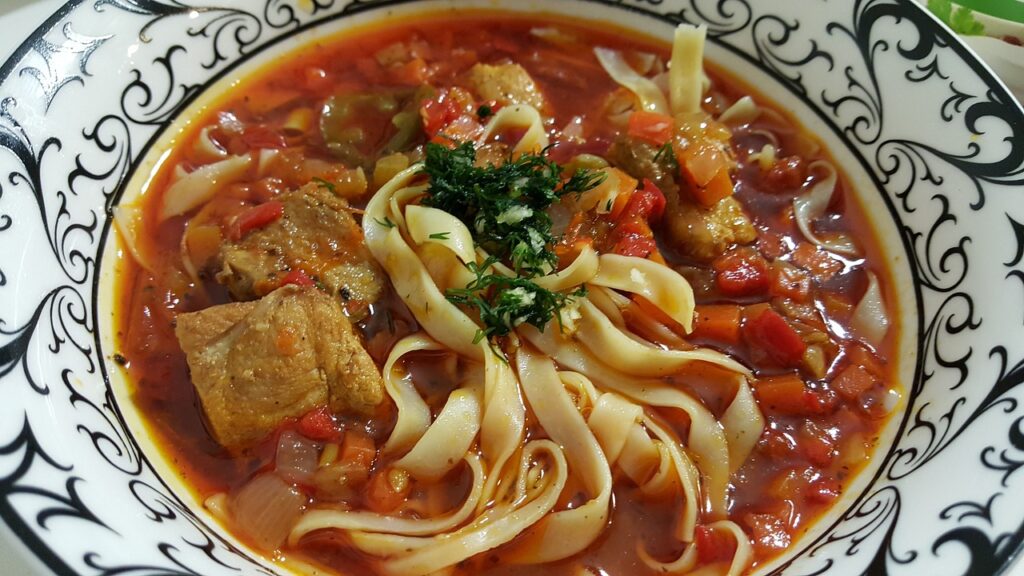Lagman – Uzbekistan’s Timeless Noodle Symphony

Introduction: In the vibrant tapestry of Uzbek cuisine, one dish stands out for its heartiness, complexity, and rich cultural heritage: lagman. This beloved noodle soup has been satisfying appetites and warming souls in the kitchens and markets of Uzbekistan for centuries. Join us on a culinary journey as we delve into the origins, ingredients, preparation, and cultural significance of this iconic dish.
Origins and History: Lagman traces its origins back to the ancient Silk Road, the historic trade route that connected East and West. As merchants and travelers traversed the vast expanse of Central Asia, they brought with them not only goods but also culinary traditions. Lagman is believed to have originated among the Uyghur people of Xinjiang, China, before spreading to neighboring regions, including Uzbekistan.
Ingredients and Flavors: At its core, lagman is a noodle soup that combines handmade noodles with a flavorful broth and an assortment of meat, vegetables, and spices. The key to a delicious lagman lies in the harmonious balance of these components.
Noodles: Lagman noodles are typically hand-pulled, giving them a distinct texture and chewiness. They are often made from wheat flour and water, rolled out into thin strands, and stretched by hand before being boiled until tender.
Broth: The broth forms the foundation of lagman’s flavor profile. It is typically made by simmering meat (such as lamb or beef) with onions, carrots, tomatoes, and a blend of aromatic spices. Common spices used in lagman broth include cumin, coriander, paprika, and garlic, which infuse the soup with warmth and depth.
Meat and Vegetables: Lagman can feature a variety of meats, including lamb, beef, or sometimes chicken. The meat is typically thinly sliced or diced and added to the soup to simmer until tender. In addition to meat, lagman is filled with an assortment of vegetables, such as carrots, bell peppers, onions, and sometimes potatoes or cabbage. These vegetables add color, texture, and nutritional value to the dish.
Spices and Seasonings: Lagman is seasoned with a blend of spices that varies depending on regional preferences and family recipes. Common spices used in lagman include cumin, coriander, paprika, turmeric, and chili flakes. These spices not only add flavor but also contribute to the vibrant colors and aromatic bouquet of the dish.
Preparation and Serving: Preparing lagman is a labor of love that requires time, skill, and attention to detail. The process begins with making the noodles from scratch, a technique that has been passed down through generations. The dough is kneaded until smooth, rolled out into thin sheets, and then cut into long, thin strips. These strips are stretched by hand to create the distinctive lagman noodles, which are then boiled until al dente.
While the noodles are cooking, the broth is prepared by simmering meat, vegetables, and spices together in a large pot. Once the noodles and broth are ready, they are combined in a serving bowl, creating a steaming, aromatic soup that is as visually appealing as it is delicious.
Lagman is often served with a side of fresh herbs, such as cilantro, parsley, or dill, which add brightness and freshness to the dish. It may also be accompanied by a wedge of lemon or lime, which can be squeezed over the soup to enhance its flavor.
Cultural Significance: Beyond its culinary appeal, lagman holds a special place in Uzbek culture and traditions. It is a dish that brings families and communities together, whether shared around the dinner table or enjoyed at festive gatherings and celebrations.
Lagman is often served during special occasions, such as weddings, holidays, and other milestones, where it symbolizes abundance, hospitality, and togetherness. It is also a popular street food, sold by vendors in bustling markets and bazaars, where the aroma of simmering broth and spices fills the air, enticing passersby to stop and savor a bowl of warm, comforting lagman.
Conclusion: In the realm of Uzbek cuisine, lagman stands as a testament to the culinary heritage and cultural richness of the region. From its humble origins along the Silk Road to its present-day status as a beloved comfort food, lagman embodies the flavors, traditions, and spirit of Uzbekistan. Whether enjoyed in a bustling market or prepared lovingly at home, a bowl of lagman is not just a meal—it is an experience that nourishes both body and soul.





